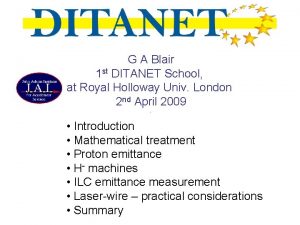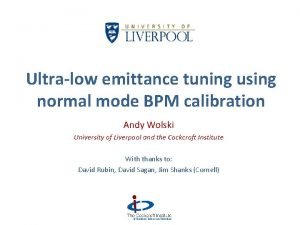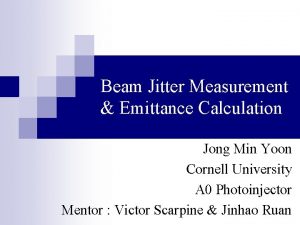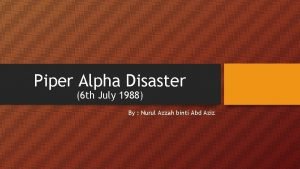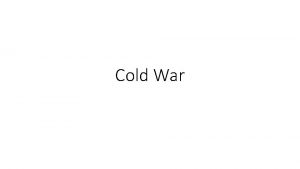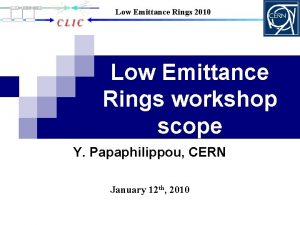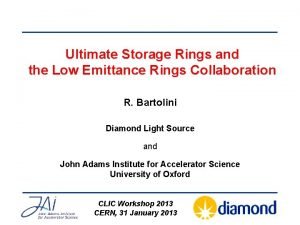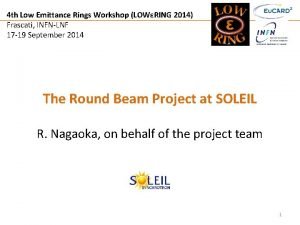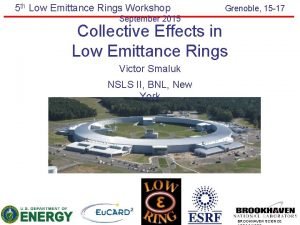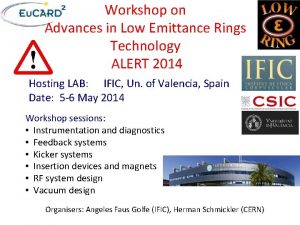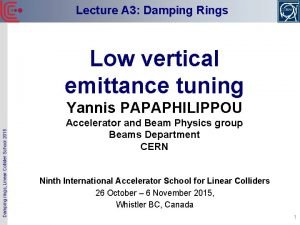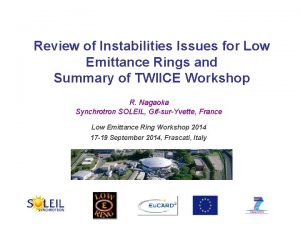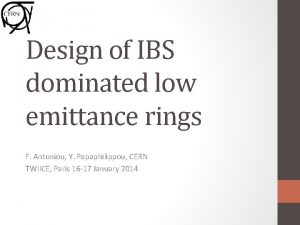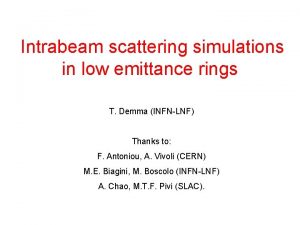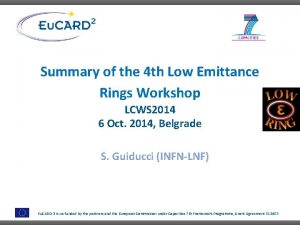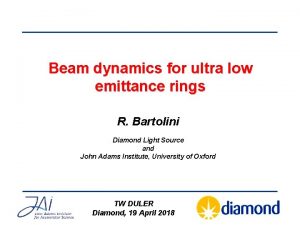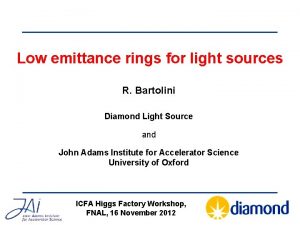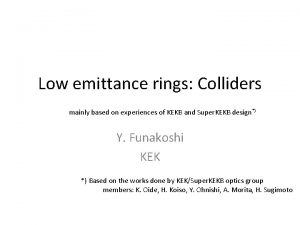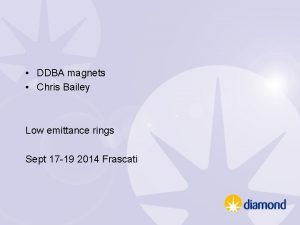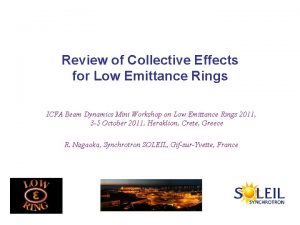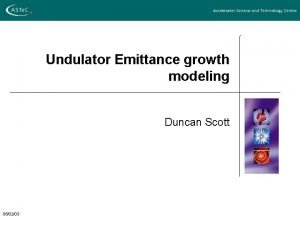Low Emittance Rings Workshop Oxford UK July 8


















- Slides: 18

Low Emittance Rings Workshop, Oxford, UK July 8, 2013 ALS Brightness Upgrade & Future Plan H. Tarawneh, C. Steier, A. Madur, D. Robin Lawrence Berkeley National Laboratory B. Bailey, A. Biocca, A. Black, K. Berg, D. Colomb, N. Li, S Marks, H. Nishimura, E. Norum, C. Pappas, G. Portmann, S. Prestemon, A. Rawlins, D. Robin, S. Rossi, F. Sannibale, T. Scarvie, R. Schlueter, C. Sun, W. Wan, E. Williams. H. Tarawneh, C. Steier, A. Madur, D. Robin. L. E. Workshop, July 9, 2013

Outline • Introduction - ALS Upgrades • Brightness Upgrade – Lattice Choice – Magnet Design – Installation/Commissioning • Future directions (ALS-II) - Pre-conceptual: Lattice, Magnets, Injection. • Summary H. Tarawneh, C. Steier, A. Madur, D. Robin. L. E. Workshop, July 9, 2013 2

Brightness Upgrade q ALS for 20 years has been extremely successful in (soft) x-ray science and newer Facilities could provide potentially better performance and better tools Brightness Upgrade Scope: Replacement of the current 46 dipole corrector magnets with 48 combined function magnets (sextupole+HCM+VCM+skew), as well as associated power supplies, controls, interlocks, chamber modifications Project Schedule: - Magnet RFP 6/2010 -Magnet Installation 10/2012 -3/2013 -Migration to low emittance 4/2013 Superbend Sourcepoints 68 microns (FWHM) 223 microns (FWHM) H. Tarawneh, C. Steier, A. Madur, D. Robin. L. E. Workshop, July 9, 2013 3

Why do we add sextupoles? • Reducing the equilibrium emittance is achieved changing settings of existing quadrupoles • Problem is nonlinear dynamics: – Sextupoles are too weak to correct chromaticity – Strengthening them would dramatically reduce dynamic aperture (lifetime, injection efficiency) • Need additional degrees of freedom – ‘Harmonic’ Sextupoles – ALS lattice already full – needed to replace existing corrector magnets with multi-magnets • Possibility for low alpha operation – THz, short bunches H. Tarawneh, C. Steier, A. Madur, D. Robin. L. E. Workshop, July 9, 2013 4

Lattices for ALS upgrade Current Lattice New Large bx Lattice New Small bx Lattice • There are several possible lattices with ~2 nm rad emittance – 3 x smaller than the nominal ALS (~6. 3 nmrad) • Large bx lattice optimizes brightness for the central bends • Small bx lattice would optimize brightness for the insertion devices further H. Tarawneh, C. Steier, A. Madur, D. Robin. L. E. Workshop, July 9, 2013 5

Baseline Lattice: Dynamic Aperture • • • Dynamic aperture is fairly large (larger than current lattice) Dynamic Momentum Aperture larger Touschek Lifetime longer than present lattice • Despite higher density H. Tarawneh, C. Steier, A. Madur, D. Robin. L. E. Workshop, July 9, 2013 6

Project History • • • Existing Received funding (summer 09) Correctors Comprehensive project review (12/09) Awarded magnet contract (9/10) Detailed magnet design review (3/11) Sextupole / Corrector Multimagnets Prototypes of 3 magnet types complete (12/11) First set of 13 production magnets shipped (4/12) All magnets received (8/12) Pre-Installed 13 of 48 sextupoles (1/13) Remaining magnets and power supplies installed (3/13) User operation in high brightness mode (2. 0 nm emittance) – since (4/13) H. Tarawneh, C. Steier, A. Madur, D. Robin. L. E. Workshop, July 9, 2013 7

Accelerator Physics Work Top-off calculations with new magnets – Re-analysis necessary, new field profiles – No hardware changes necessary – Wider ranges on topoff interlocks New fs-slicing bump for new lattice – – Using MOGA optimization techniques Making use of new skew quadrupoles Also evaluating to switch to horizontal slicing Shorter pulses Supporting analysis of magnet test results – Reducing Commissioning Risk – Hysteresis – Bandwidth – Multipole content Continuing work to explore low bx lattices H. Tarawneh, C. Steier, A. Madur, D. Robin. L. E. Workshop, July 9, 2013 8

Commissioning Results • Installation completed on time (Mar/Apr 2013) • Quick Commissioning Progress – Benefit of pre-installation and commissioning: orbit feedbacks, detuned upgrade lattice Measured horizontal photon beam profiles showing the reduction in size and increase in brightness. Above: BL 12. 3. 2, Below: BL 6. 3. 1 • Managed to deliver low emittance beam during BLC shifts – and continue into user operations – 3 months ahead of schedule • Beamlines able to resolve brightness increase • Reliable operation (no faults due to new lattice or hardware so far) H. Tarawneh, C. Steier, A. Madur, D. Robin. L. E. Workshop, July 9, 2013 9

Beamsize and Beam Dynamics Measurements Beamsize Reduction BL 6. 3. 1 Confirmed larger dynamic and momentum aperture than high emittance lattice H. Tarawneh, C. Steier, A. Madur, D. Robin. L. E. Workshop, July 9, 2013 10

Brightness Comparison • Comparison to existing and future light sources (and upgrades) • Below 1 ke. V (soft x-ray) ALS is competitive now • Future: NSLS-II and Max-4 will outperform ALS Triple Bend Achromat provides very bright bend and Superbend source points from center bend magnets – above 100 e. V ALS (2 nm) above NSLS-II 3 PW H. Tarawneh, C. Steier, A. Madur, D. Robin. L. E. Workshop, July 9, 2013 11

H. Tarawneh, C. Steier, A. Madur, D. Robin. L. E. Workshop, July 9, 2013

Looking beyond completed Brightness Upgrade: Assuring world class capabilities for the future new magnets old magnets Diffraction Limit upgrade on a 200 m circumference ring enables nanoscale microscopes with chemical, magnetic, and electronic resolution Chemical Maps From 20 nm to 2 nm; from 2 D to 3 D Resolve nano-interfaces in a cathode Observe the flux in a catalytic network Potential upgrade of ALS ring to diffraction limit Electronic Maps nano. ARPES of complex phases at 25 nm resolution angle 100 x increase in brightness Magnetic Maps Thermally-driven domain fluctuations imprinted in speckle at nm resolution H. Tarawneh, C. Steier, A. Madur, D. Robin. L. E. Workshop, July 9, 2013 13

Diffraction Limited Light Sources q Recent realization: Still large potential for storage ring sources • • Smaller vacuum+magnet aperture – Multi bend achromat lattices with low emittance. Actively pursued: MAX-IV, SIRIUS, ESRF-2, Spring 8 -2, BAPS, … q Transverse diffraction limited to 2 ke. V for ALS size is possible – ALS-II • Using the ALS tunnel to achieve moderate low emittance with moderate cost. H. Tarawneh, C. Steier, A. Madur, D. Robin. L. E. Workshop, July 9, 2013

Ongoing Conceptual Machine Design Work Active Areas of Conceptual Machine Design: • Lattice Optimization • Injection • Collective Effects • Engineering Considerations (Magnets-DC/pulsed, RF, Vacuum) • Cost/Schedule H. Tarawneh, C. Steier, A. Madur, D. Robin. L. E. Workshop, July 9, 2013

ALS-II Magnet System q Third generation light sources = generous physical apertures (except for IDs which define much smaller admittance) – smaller apertures (factor 3) = much stronger magnets q Nowadays field quality with smaller magnet apertures achievable q MBA lattices provide smaller natural emittances q NEG coating - distributed pumping in small chambers (cheaper) 0. 78 T & 50 T/m Pole Tip Flux: 1. 0 T 80 T/m Pole Tip Flux: 0. 9 T H. Tarawneh, C. Steier, A. Madur, D. Robin. L. E. Workshop, July 9, 2013 3000 T/m 2 Pole Tip Flux 0. 45 T

ALS-II Injection Scheme q On-axis injection into SR due to small DA Accumulator Ring (AC). q Accumulator ring shares the SR tunnel. AC Lattice Req. (a) DA of ± 10 mm. (b) Lifetime ≥ 2 h. (c) Minimum 4 Straight sections. q Partial Swap-out injection is foreseen Relax requirements on AC ring & pulsed magnets, I=100 m. A Bunch Trains Brightness evolution Stored train Injected train Storage Ring Stored train Accumulator Ring injecting 0. 1*Ibeam H. Tarawneh, C. Steier, A. Madur, D. Robin. L. E. Workshop, July 9, 2013

Summary • Biggest challenge (as well as opportunity) for ALS – Continuous Renewal – Well balanced plan between machine/facilities upgrades and beamline/endstation renewal • Major Machine Renewal example: Brightness upgrade reduced horizontal emittance from 6. 3 to 2. 0 nm • Beamlines can resolve brightness increase and realize (full) benefit • Dramatic performance improvements beyond ALS are possible (at moderate cost) and are now being actively studied. H. Tarawneh, C. Steier, A. Madur, D. Robin. L. E. Workshop, July 9, 2013 18
 Linac22
Linac22 Bpm tuning
Bpm tuning Emittance
Emittance High precision vs high accuracy
High precision vs high accuracy Low voltage hazards
Low voltage hazards Mid low high
Mid low high Supportive communication style
Supportive communication style 2001 july 15
2001 july 15 Poppies in july poem
Poppies in july poem March april may june july
March april may june july Slidetodoc.com
Slidetodoc.com July 1-4 1863
July 1-4 1863 What is the significance of july 4 1776 brainpop
What is the significance of july 4 1776 brainpop July 26 1953
July 26 1953 June too soon july stand by
June too soon july stand by July 12 1776
July 12 1776 2003 july 17
2003 july 17 July 10 1856
July 10 1856 July 14 1789
July 14 1789
